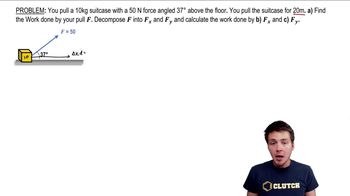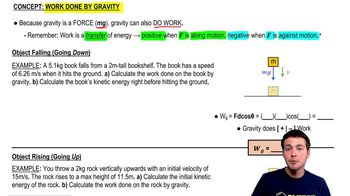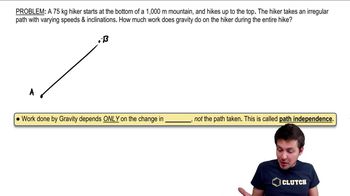>> Let's talk a little bit about this idea of work. When you guys hear that word "work," what do you think of? When you hear the word "work," what do you guys think of? Anything that comes to mind. What's that? [ Laughter ] I missed it. I missed the joke. When you think of work, what do you think of? Do you think, oh, I got to get up? I got to go to work, right? You think, oh, end of the classes today. Now I have to go to work. So when you go to work, what do you do, right? You drive somewhere. You go to an office building. You push papers around all day, right. You make photocopies. You are doing stuff at your work, right, and this is why they're paying you because you need to do stuff. And that stuff that you have to do is really about moving things around, right. Moving things from here to there. In fact, if you go look at the construction guys that are building the engineering and interdisciplinary sciences complex, they are working really hard, right. They are taking these big, heavy things and they are moving them all the time. So work is intimately involved with this idea of moving something from here to there. And to move something from here to there, you have to apply a force. So let's think about how this works. Let's say we're going to accelerate a block, which we know how to do. If I have a table here, and I put a block on that table, and then I pull on it, I can accelerate it. So let's pull on it to the right with some force F. Let's say that it maybe initially was moving. It had some Vi. And now when it gets way over here, it's going to be moving with some Vf, okay. And so we will apply that force over this distance delta x. Now, you sort of know what's going to happen here, right. The box is going to speed up in this case, right. If it's moving along with Vi and we pull on it to the right, it's going to be moving faster than it was before. But how does all this stuff relate? One thing that we know is the good, old kinematic equations, those work. So let's go back to the kinematic equations and let's look at the one that has velocities and distances. And the one that I'm thinking of is this right here -- Vf squared equals Vi squared plus 2a delta x, okay. Everybody remembers that one. But we don't know exactly what a is. But if the box is mass m and we're pulling on the box with a force F, then, in fact, we do know what a is, right. It's just F over m. So this whole thing becomes Vf squared equals Vi squared plus (2 times (F over m)) times delta x, okay. Good, old kinematic equations. Now we applied Newton's Second Law. We put that in there as well. Okay, but we can rewrite this stuff because this looks a little ugly here, right, the 2(F over m). So let's rewrite that. Let's divide everything by 2. One-half Vf squared equals 1/2 Vi squared plus (F over m) times delta x. But now let's get rid of the m by multiplying everything by m. And if I do that, what does this become? One-half m Vf squared equals 1/2 m Vi squared plus F delta x. And that's starting to look a little familiar, right, because what is 1/2 m V squared? That's our good, old kinetic energy. And so let's rewrite this slightly. I'm going to move the 1/2 m Vi squared over to the other side. And then apparently, it's equal to this F delta x. But this is kinetic energy. This is final kinetic energy. This is initial kinetic energy. This is just a change in the kinetic energy of the object. What about this? Can we call that something special? And the answer is yeah. Let's call that something special. Let's call that thing the work W, okay. What is work? Work W is equal to F delta x. Force over a distance, okay. Of course, the Work Kinetic Energy Theorem, and what it says is that W goes to changing the kinetic energy, okay. So in that simple system that we just looked at, the work that you put into it went into speeding up the box, all right. Now, this is a very sort of select subset of the overall Law of Conservation of Energy, but it's an important one to understand. Okay, so if work W is equal to F delta x, then when we speed up the block by pulling on it to the right, we can increase its kinetic energy. But what if we're pulling up at some angle F and the block is still moving to the right delta x? How do we calculate the work in this case? Well, if that force is up at an angle theta, and it has components to it, horizontal and vertical, and it turns out that only the horizontal component is critical to calculating the work. And so the work W is, in fact, F cosine theta times delta x, okay. This was sort of a special case that we had over here because we were pulling it perfectly horizontal. But now if we're pulling up at an angle, you have to use cosine of theta in there. So what are these things? F is, of course, the force applied, right. How hard are you pulling on this thing? Delta x is the displacement, okay. How far have you gone and in what direction have you gone? And therefore, theta is the angle between those two things, F and delta x. F is a vector. Delta x is a vector. There must be an angle between them, and that's what you put in for theta. Okay, so let's go back to the case where we just had the force pulling directly to the right. So if the force is pulling directly to the right-- And the displacement is also to the right, now we can calculate the work. Work W is F cosine theta delta x, but what is theta in this case? Theta, remember, is the angle between the force and the displacement. So if they're both in the same direction, what do I want to put here for theta? Zero, right? They're both in the same direction, so the angle between those two vectors is zero degrees. What's cosine of zero degrees? One. And so we just get back to what we had a second ago, okay. Work is F delta x if the force is perfectly horizontal. All right. Let's try a slightly different problem. Let's say that we're going to lift the object up by applying a force, F lift, but we're still going to move it to the right, okay. So here's the box. You lift up the box, and then you move it nice and slow to the right. How much work have we done in that case? Well, we know that it is. Work is F cosine theta delta x. The force that we apply is F lift. What's the angle between those two? Ninety degrees. What's the cosine of 90 degrees? Zero. So in this case, what we're saying is we haven't done any work at all. The work is equal to zero. Does that seem right? Omar, what do you think? [ Inaudible Speaker ] So I'm lifting it up, and then I'm just going to move it real slowly to the right, okay. And we just said that the work is equal to zero. You like that answer? [ Inaudible Speaker ] Okay, mathematically, he likes it. But let's think about it from the point of view of myself lifting up this box, right. I have this box right here, and now I'm going to move it slowly to the right. Why do I mean slowly? Because the Work Kinetic Energy Theorem says that if you don't have any work, you can't have any change in kinetic energy. We know if I push it really fast, then I am applying a force in that direction, and that will change the kinetic energy. And therefore, you have done work. But if I move it slow like this, then my force is basically up. The displacement is to the right. And so I've done zero work on it. But I can't do this all day, right, even with something as lightweight as my cell phone. Although with this wood case, it suddenly got a lot more massive. I can't do this all day, right? Why can't I do this all day? Because eventually my arms are going to get tired. It gets heavy. So what's the difference? How come it feels like I'm doing work and yet we just said that there's no work being done? How do we reconcile that? Are you guys getting hypnotized? You're getting sleepy. [ Inaudible Speaker ] Okay. It's not doing work on me because gravity is straight down, and so the gravitational work, if it's moving horizontally, is also zero, right. The difference is rather subtle. It's this. When I hold up an object as a human, I have to exert some energy to do that because it takes me physiological work to lift it up. Why? Because I have a heart that's pumping blood, going through my system. There's friction. It's generating a lot of heat. My muscles are, in fact, twitching ever so slightly as you go. And all of that burns energy, and that takes physiological work, okay. So physiological work is not the same as physical work, how we define work in physics, but it is there as a human being, right. As a human being, it just takes a lot of energy to be alive, right. You're 98.6 degrees. You're radiating all this energy all the time, okay. But physically, we say it takes zero work. All right.
Table of contents
- 0. Math Review31m
- 1. Intro to Physics Units1h 23m
- 2. 1D Motion / Kinematics3h 56m
- Vectors, Scalars, & Displacement13m
- Average Velocity32m
- Intro to Acceleration7m
- Position-Time Graphs & Velocity26m
- Conceptual Problems with Position-Time Graphs22m
- Velocity-Time Graphs & Acceleration5m
- Calculating Displacement from Velocity-Time Graphs15m
- Conceptual Problems with Velocity-Time Graphs10m
- Calculating Change in Velocity from Acceleration-Time Graphs10m
- Graphing Position, Velocity, and Acceleration Graphs11m
- Kinematics Equations37m
- Vertical Motion and Free Fall19m
- Catch/Overtake Problems23m
- 3. Vectors2h 43m
- Review of Vectors vs. Scalars1m
- Introduction to Vectors7m
- Adding Vectors Graphically22m
- Vector Composition & Decomposition11m
- Adding Vectors by Components13m
- Trig Review24m
- Unit Vectors15m
- Introduction to Dot Product (Scalar Product)12m
- Calculating Dot Product Using Components12m
- Intro to Cross Product (Vector Product)23m
- Calculating Cross Product Using Components17m
- 4. 2D Kinematics1h 42m
- 5. Projectile Motion3h 6m
- 6. Intro to Forces (Dynamics)3h 22m
- 7. Friction, Inclines, Systems2h 44m
- 8. Centripetal Forces & Gravitation7h 26m
- Uniform Circular Motion7m
- Period and Frequency in Uniform Circular Motion20m
- Centripetal Forces15m
- Vertical Centripetal Forces10m
- Flat Curves9m
- Banked Curves10m
- Newton's Law of Gravity30m
- Gravitational Forces in 2D25m
- Acceleration Due to Gravity13m
- Satellite Motion: Intro5m
- Satellite Motion: Speed & Period35m
- Geosynchronous Orbits15m
- Overview of Kepler's Laws5m
- Kepler's First Law11m
- Kepler's Third Law16m
- Kepler's Third Law for Elliptical Orbits15m
- Gravitational Potential Energy21m
- Gravitational Potential Energy for Systems of Masses17m
- Escape Velocity21m
- Energy of Circular Orbits23m
- Energy of Elliptical Orbits36m
- Black Holes16m
- Gravitational Force Inside the Earth13m
- Mass Distribution with Calculus45m
- 9. Work & Energy1h 59m
- 10. Conservation of Energy2h 54m
- Intro to Energy Types3m
- Gravitational Potential Energy10m
- Intro to Conservation of Energy32m
- Energy with Non-Conservative Forces20m
- Springs & Elastic Potential Energy19m
- Solving Projectile Motion Using Energy13m
- Motion Along Curved Paths4m
- Rollercoaster Problems13m
- Pendulum Problems13m
- Energy in Connected Objects (Systems)24m
- Force & Potential Energy18m
- 11. Momentum & Impulse3h 40m
- Intro to Momentum11m
- Intro to Impulse14m
- Impulse with Variable Forces12m
- Intro to Conservation of Momentum17m
- Push-Away Problems19m
- Types of Collisions4m
- Completely Inelastic Collisions28m
- Adding Mass to a Moving System8m
- Collisions & Motion (Momentum & Energy)26m
- Ballistic Pendulum14m
- Collisions with Springs13m
- Elastic Collisions24m
- How to Identify the Type of Collision9m
- Intro to Center of Mass15m
- 12. Rotational Kinematics2h 59m
- 13. Rotational Inertia & Energy7h 4m
- More Conservation of Energy Problems54m
- Conservation of Energy in Rolling Motion45m
- Parallel Axis Theorem13m
- Intro to Moment of Inertia28m
- Moment of Inertia via Integration18m
- Moment of Inertia of Systems23m
- Moment of Inertia & Mass Distribution10m
- Intro to Rotational Kinetic Energy16m
- Energy of Rolling Motion18m
- Types of Motion & Energy24m
- Conservation of Energy with Rotation35m
- Torque with Kinematic Equations56m
- Rotational Dynamics with Two Motions50m
- Rotational Dynamics of Rolling Motion27m
- 14. Torque & Rotational Dynamics2h 5m
- 15. Rotational Equilibrium3h 39m
- 16. Angular Momentum3h 6m
- Opening/Closing Arms on Rotating Stool18m
- Conservation of Angular Momentum46m
- Angular Momentum & Newton's Second Law10m
- Intro to Angular Collisions15m
- Jumping Into/Out of Moving Disc23m
- Spinning on String of Variable Length20m
- Angular Collisions with Linear Motion8m
- Intro to Angular Momentum15m
- Angular Momentum of a Point Mass21m
- Angular Momentum of Objects in Linear Motion7m
- 17. Periodic Motion2h 9m
- 18. Waves & Sound3h 40m
- Intro to Waves11m
- Velocity of Transverse Waves21m
- Velocity of Longitudinal Waves11m
- Wave Functions31m
- Phase Constant14m
- Average Power of Waves on Strings10m
- Wave Intensity19m
- Sound Intensity13m
- Wave Interference8m
- Superposition of Wave Functions3m
- Standing Waves30m
- Standing Wave Functions14m
- Standing Sound Waves12m
- Beats8m
- The Doppler Effect7m
- 19. Fluid Mechanics2h 27m
- 20. Heat and Temperature3h 7m
- Temperature16m
- Linear Thermal Expansion14m
- Volume Thermal Expansion14m
- Moles and Avogadro's Number14m
- Specific Heat & Temperature Changes12m
- Latent Heat & Phase Changes16m
- Intro to Calorimetry21m
- Calorimetry with Temperature and Phase Changes15m
- Advanced Calorimetry: Equilibrium Temperature with Phase Changes9m
- Phase Diagrams, Triple Points and Critical Points6m
- Heat Transfer44m
- 21. Kinetic Theory of Ideal Gases1h 50m
- 22. The First Law of Thermodynamics1h 26m
- 23. The Second Law of Thermodynamics3h 11m
- 24. Electric Force & Field; Gauss' Law3h 42m
- 25. Electric Potential1h 51m
- 26. Capacitors & Dielectrics2h 2m
- 27. Resistors & DC Circuits3h 8m
- 28. Magnetic Fields and Forces2h 23m
- 29. Sources of Magnetic Field2h 30m
- Magnetic Field Produced by Moving Charges10m
- Magnetic Field Produced by Straight Currents27m
- Magnetic Force Between Parallel Currents12m
- Magnetic Force Between Two Moving Charges9m
- Magnetic Field Produced by Loops and Solenoids42m
- Toroidal Solenoids aka Toroids12m
- Biot-Savart Law (Calculus)18m
- Ampere's Law (Calculus)17m
- 30. Induction and Inductance3h 37m
- 31. Alternating Current2h 37m
- Alternating Voltages and Currents18m
- RMS Current and Voltage9m
- Phasors20m
- Resistors in AC Circuits9m
- Phasors for Resistors7m
- Capacitors in AC Circuits16m
- Phasors for Capacitors8m
- Inductors in AC Circuits13m
- Phasors for Inductors7m
- Impedance in AC Circuits18m
- Series LRC Circuits11m
- Resonance in Series LRC Circuits10m
- Power in AC Circuits5m
- 32. Electromagnetic Waves2h 14m
- 33. Geometric Optics2h 57m
- 34. Wave Optics1h 15m
- 35. Special Relativity2h 10m
9. Work & Energy
Intro to Calculating Work
Video duration:
13mPlay a video:
Related Videos
Related Practice













